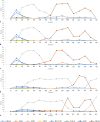Pilot-Scale Preparation of Broad-Spectrum CBD: Extraction Optimization and Purification using Centrifugal Partition Chromatography
- PMID: 40524919
- PMCID: PMC12169812
- DOI: 10.1159/000546263
Pilot-Scale Preparation of Broad-Spectrum CBD: Extraction Optimization and Purification using Centrifugal Partition Chromatography
Abstract
Introduction: Cannabinoids, a class of compounds found in Cannabis sativa L., possess a wide range of pharmacological properties. While Δ9-tetrahydrocannabinol (Δ9-THC) is strictly regulated owing to its psychoactive effects, cannabidiol (CBD), a nonpsychoactive compound, is permitted in certain countries. This study aimed to optimize the preparation of ethanolic cannabis extracts using response surface methodology (RSM) and develop an effective system for removing Δ9-THC through centrifugal partition chromatography (CPC) to produce broad-spectrum CBD (hemp extract containing CBD and other compounds with minimal or no Δ9-THC).
Methods: Three variables and six responses were assessed to optimize extraction conditions. Predictions were made using Design-Expert® software, and the experimental conditions were identified using the Box-Behnken design (BBD). The extracts were analyzed using high-performance liquid chromatography and a chromameter. Optimal conditions were used for pilot-scale extraction, and the CPC process was optimized by determining the partition coefficient of the target cannabinoids in various solvent systems and maximum sample load.
Results: The optimal extraction conditions were -31°C for 33 min and a sample-to-solvent ratio of 1:8% w/v, with a desirability value of 0.576. Temperature was the most influential factor. Although the total yield decreased, this condition provided the highest concentration of light-colored cannabinoids and was successfully scaled up for the three other cannabis samples. The optimal CPC solvent system, consisting of hexane/0.1% FA in ACN/20 mm ammonium formate at a ratio of 10/6.5/3.5 v/v/v, demonstrated a yield recovery of 89.3 ± 0.21% w/w with a maximum load of 5 g of sample per run. The resulting broad-spectrum CBD extract had a high CBD content (73.3 ± 0.37% w/w) and minimal Δ9-THC content (0.2 ± 0.00% w/w).
Conclusion: BBD-RSM optimization of ethanolic cannabis extraction provided the highest cannabinoid concentration with a short extraction time and desirable appearance. The CPC process successfully separated Δ9-THC, yielding a high-purity broad-spectrum CBD extract.
Keywords: Broad-spectrum cannabidiol; Cannabinoids; Centrifugal partition chromatography; Extraction optimization.
© 2025 The Author(s). Published by S. Karger AG, Basel.
Conflict of interest statement
The authors declare that they have no conflicts of interest.
Figures


Similar articles
-
In Situ Decarboxylation-Pressurized Hot Water Extraction for Selective Extraction of Cannabinoids from Cannabis sativa. Chemometric Approach.Molecules. 2021 Jun 2;26(11):3343. doi: 10.3390/molecules26113343. Molecules. 2021. PMID: 34199346 Free PMC article.
-
Effective determination of the principal non-psychoactive cannabinoids in fiber-type Cannabis sativa L. by UPLC-PDA following a comprehensive design and optimization of extraction methodology.Anal Chim Acta. 2021 Mar 15;1150:338200. doi: 10.1016/j.aca.2021.338200. Epub 2021 Jan 18. Anal Chim Acta. 2021. PMID: 33583544
-
Analysis of cannabidiol (CBD) and THC in nonprescription consumer products: Implications for patients and practitioners.Epilepsy Behav. 2022 Feb;127:108514. doi: 10.1016/j.yebeh.2021.108514. Epub 2022 Jan 5. Epilepsy Behav. 2022. PMID: 34998268
-
Using the BMD Approach to Derive Acceptable Daily Intakes of Cannabidiol (CBD) and Tetrahydrocannabinol (THC) Relevant to Electronic Cigarette Liquids.Front Biosci (Landmark Ed). 2022 Jul 25;27(8):228. doi: 10.31083/j.fbl2708228. Front Biosci (Landmark Ed). 2022. PMID: 36042166
-
Emerging challenges in the extraction, analysis and bioanalysis of cannabidiol and related compounds.J Pharm Biomed Anal. 2021 Jan 5;192:113633. doi: 10.1016/j.jpba.2020.113633. Epub 2020 Sep 20. J Pharm Biomed Anal. 2021. PMID: 33039911 Review.
References
LinkOut - more resources
Full Text Sources

